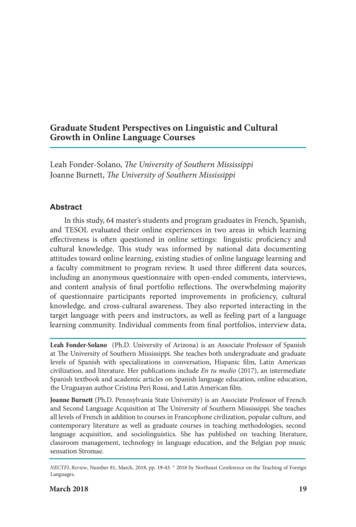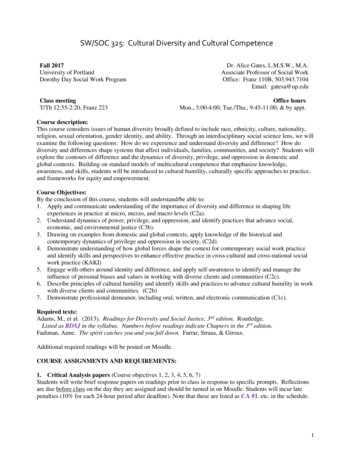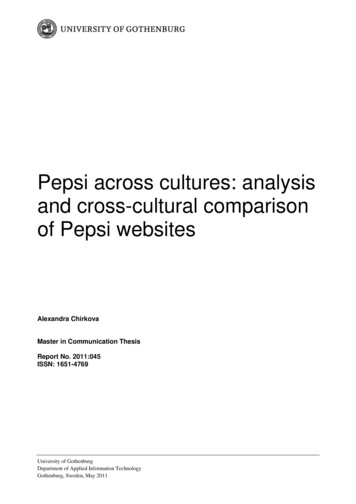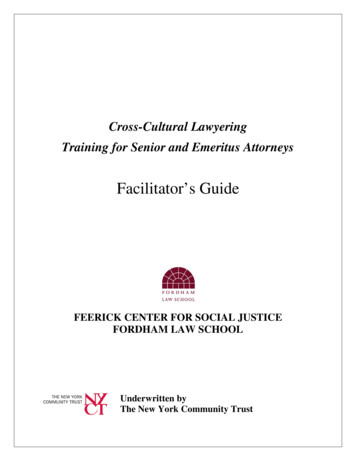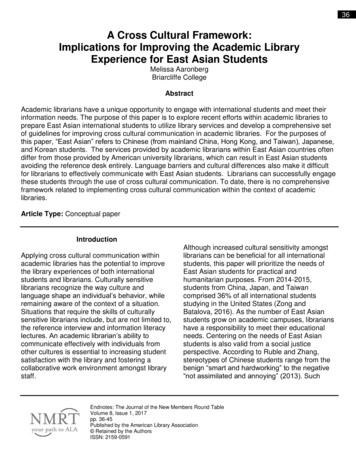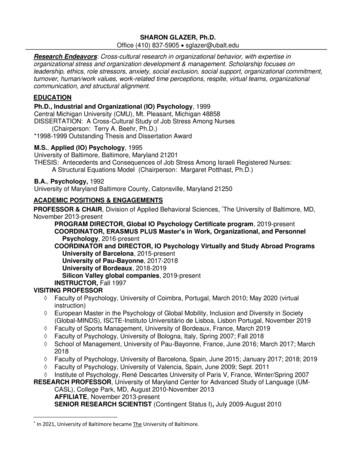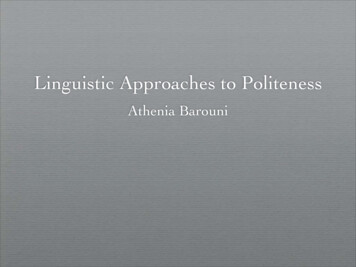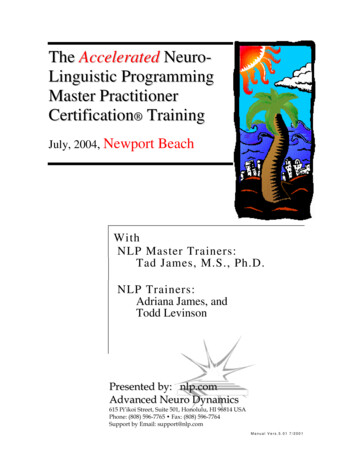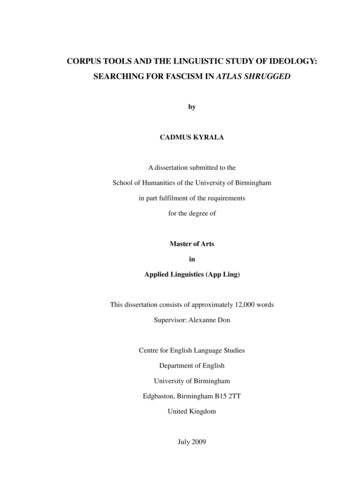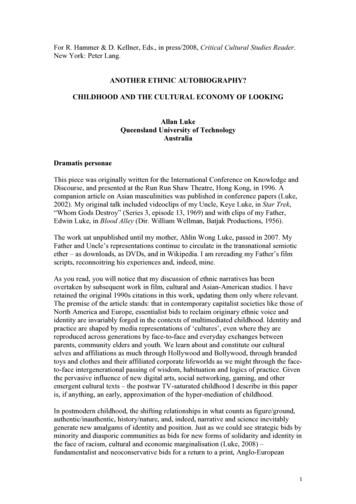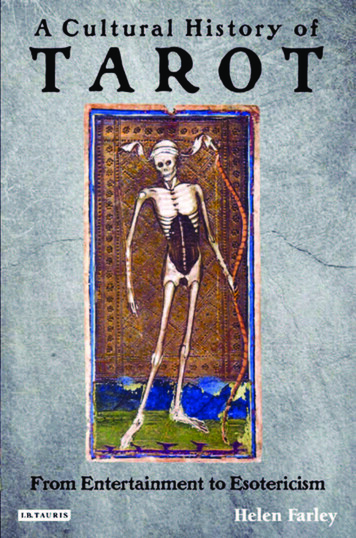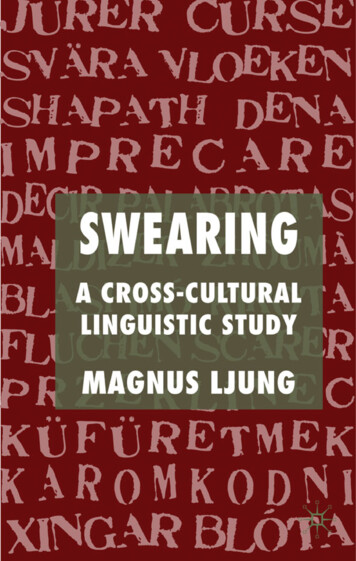
Transcription
Swearing
Also by Magnus LjungSelected publicationsA FREQUENCY DICTIONARY OF ENGLISH MORPHEMESREFLECTIONS ON THE ENGLISH PROGRESSIVEMAKING WORDS IN ENGLISHCORPUS-BASED STUDIES IN ENGLISHSVORDOMSBOKEN [THE BOOK OF SWEARING]
SwearingA Cross-Cultural Linguistic StudyMagnus LjungUniversity of Stockholm, Sweden
Magnus Ljung 2011All rights reserved. No reproduction, copy or transmission of thispublication may be made without written permission.No portion of this publication may be reproduced, copied or transmittedsave with written permission or in accordance with the provisions of theCopyright, Designs and Patents Act 1988, or under the terms of any licencepermitting limited copying issued by the Copyright Licensing Agency,Saffron House, 6–10 Kirby Street, London EC1N 8TS.Any person who does any unauthorized act in relation to this publicationmay be liable to criminal prosecution and civil claims for damages.The author has asserted his right to be identified as the author of this workin accordance with the Copyright, Designs and Patents Act 1988.First published 2011 byPALGRAVE MACMILLANPalgrave Macmillan in the UK is an imprint of Macmillan Publishers Limited,registered in England, company number 785998, of Houndmills, Basingstoke,Hampshire RG21 6XS.Palgrave Macmillan in the US is a division of St Martin’s Press LLC,175 Fifth Avenue, New York, NY 10010.Palgrave Macmillan is the global academic imprint of the above companiesand has companies and representatives throughout the world.Palgrave and Macmillan are registered trademarks in the United States,the United Kingdom, Europe and other countries.ISBN 978–0–230–57631–5hardbackThis book is printed on paper suitable for recycling and made from fullymanaged and sustained forest sources. Logging, pulping and manufacturingprocesses are expected to conform to the environmental regulations of thecountry of origin.A catalogue record for this book is available from the British Library.A catalog record for this book is available from the Library of Congress.10 9 8 7 6 5 4 32 120 19 18 17 16 15 14 13 12 11Printed and bound in Great Britain byCPI Antony Rowe, Chippenham and Eastbourne
ContentsList of FiguresviList of onxiList of Abbreviations1xiiDefining Swearing12 A Typology of Swearing243 History of Swearing45474Expletive Interjections5 Oaths, Emphatic Denials, Curses976 Ritual Insults, Name-Calling, Unfriendly Suggestions1147 Degree, Dislike, Emphasis, Exasperation and Annoyance1438161Replacive 86v
List of Figures4.1Gehweiler’s classification of the expletive interjections806.1Classification of evaluative nouns1257.1Classification of bloody, damn(ed), fuckingand similar words153vi
List of Tables2.1Distribution of sex organ epithets in three Scandinavianlanguages394.1Swearing exclamations in 25 languages754.2Utterances preceding he/she exclaimed in the BNC764.3Combining habits of 10 common English taboo wordsin interjections814.4Rank list of expletive interjections in Conv1M924.5Distribution of the expletive interjections946.1Distribution of mother-theme insults1216.2Swedish swearing in the Tensta study1226.3The major English expletive epithets1306.4Distribution of English expletive epithets acrosstaboo themes1327.1Distribution of expletive slot fillers in spoken BNC1457.2Distribution of bloody and fucking across functions155vii
PrefaceThis book is a study of swearing, its shape, use and manifestations inEnglish and a number of other languages. The discussion and manyof the examples in the book are in English, but there will also be moreor less extensive forays into a number of other languages, viz. Arabic,Cantonese, Danish, Dutch, Estonian, Finnish, French, German, Greek,Hindi, Hungarian, Icelandic, Italian, Japanese, Mandarin, Norwegian,Polish, Portuguese, Russian, Spanish, Swahili, Swedish, Turkish andUrdu. Although the data from these languages have been obtainedin many different ways, my primary source of information has beeninterviews with native speakers based on the questionnaire presented inAppendix 2. The information obtained in this manner varied with thenumber of native speakers available and my account of swearing in thedifferent languages makes no claim to completeness.Swearing often involves the use of four-letter words like English fuck,shit and the corresponding terms in other languages, and on accountof this it is regarded by many as disrespectful, vulgar and offensive.Some also regard it as blasphemous on account of its frequent unserioususe of religious words. Interestingly enough, however, and despitethese negative characteristics, swearing also seems fill a need for manypeople who find that the vulgar and offensive nature of swearing makesit an ideal tool for adding emphasis to what one says.In addition to the above sociolinguistic characteristics, swearing alsohas a number of linguistic features that make it well worth studying,features involving aspects of vocabulary, grammar and meaning.The vocabulary items used in swearing consist of a limited numberof taboo words, viz. words whose literal meanings denote semanticareas that are – as Hughes (2006: 462) puts it – ‘too private, too vileor too sacred’ to be mentioned. In the present study, these areasare referred to as taboo themes and comprise for example excrement,incest and sex, on the one hand, and religious concepts on the other.However, taboo is not merely a question of word content but also ofword form: the word itself must be offensive. Penis and prick denotethe same theme, but only the second is offensive and hence a swearword. It is an interesting but so far unresolved question whether taboohas more to do with form or with content (cf. Hughes 2006: 462 andthe discussion in Chapter 1).viii
PrefaceixGrammatically, swearing is characterized by its formulaicity, viz. thefact that multi-word swearing expressions are not freely formed inaccordance with the grammar of the language but are more or less fixedand resist formal change.Semantically, swearing is special not merely because of the restrictions on its vocabulary, but also by the fact that the taboo wordsinvolved are not used with their referential or denotative meanings,but function exclusively as indications of the speaker’s state of mind.Consequently swearing does not have meaning in the sense that referential expressions do. Instead it has emotive meaning, viz. it expresses thespeaker’s state of mind.Finally, swearing has a number of distinct functions. In some of these,swearing is an utterance of its own, such as for example exclamationsof anger, surprise like Shit! and Bloody hell!, unfriendly suggestions likeGo to hell!, or curses like Damn you! In other functions the swearingexpressions are part of an utterance, for example bloody, like hell, andthe devil as in It was bloody difficult, We ran like hell and What the devil doyou mean? In combination with the swearing themes mentioned above,the functions provide a convenient method for describing individualinstances of swearing.The characteristics outlined above are shared by all swearing and serveto establish it as a linguistic category of its own, not only in Englishand other languages but across language boundaries. It is preciselybecause of these commonalities of swearing that – in a study like thepresent one – we are able to identify and compare swearing expressionsfrom different languages with each other, irrespective of the particularnames used for that activity.Such comparisons make it clear that with a few exceptions the swearing ‘machinery’ in different languages is basically the same and that theperceived differences between languages in this respect are mostly due todifferent taboo word choices from the same set of swearing themes.Admittedly the number of languages available for such comparisonin this study amounts to no more than 25 and granted that there aretoday at least 5000 different languages in the world, the data in thepresent study are far from sufficient for a full-scale comparison betweenswearing systems. However, despite the fact that decisions about thescope of my study were affected by the availability of native speakers,the choice of languages represented do permit certain limited comparisons between language families, cultures and religions, as the statisticsin Appendix 1 indicate.
AcknowledgementsA study like the present one would have been impossible without thecooperation of a vast number of informants willing to answer thequestions in the questionnaire and discuss the issues arising from thatprocess, often offering information on the finer points of swearing intheir own language about which I would otherwise have remained ignorant. I am deeply grateful to all of them. I would like to thank KingsleyBolton for his comments on various aspects of my work and AntoinetteRenouf, Andrew Kehoe and Rodopi for permission to use copyrightmaterial from Corpus Linguistics: Refinements and Reassessments. FinallyI would like to thank my wife Kerstin for her support and assistance.x
TransliterationSeveral of the languages included in this study have writing systemsthat require transliteration (romanization) in order to be representedin English. In most cases this does not present a problem since theexamples used in the literature have already been adapted to Englishspelling. In the case of Russian, however, it is often the case thatexamples in the literature are written in the Cyrillic alphabet, for whichthere are several romanization systems available.In the present study I have mainly followed the spelling suggestionsin the so-called Scholarly romanization system as described underRomanization of Russian in the Wikipedia Encyclopedia. My only deviation from the Scholarly system is the adoption of the spelling yo forRussian Cyrillic ë. As a consequence, the well-known Russsian insultmeaning ‘Somebody has fucked your mother’ has been realized in thepresent book as Yob tvojú mat’.In the representation of data from Cantonese and Mandarin the different tones have been indicated in accordance with the Yale system.xi
List of AbbreviationsBNCThe British National CorpusCassellCassell’s Dictionary of SlangCOCACorpus of Contemporary American EnglishCOEDCorpus of English DialoguesCNPDThe Concise New Partridge Dictionary of Slang andUnconventional EnglishODEThe Oxford Dictionary of EnglishOEDThe Oxford English Dictionaryxii
1Defining Swearing1.0 Swearing in the dictionariesAlthough swearing is an English term denoting a particular type oflinguistic behaviour, it is often used in studies of other languages todenote a linguistic resource whose functions and realizations acrosslanguages are remarkably similar and seem to emanate from a common pool of emotive utterance types. Given this basic cross-linguisticsimilarity and the fact that the English term is a well-established one,swearing will be used throughout the present book as a name for therealizations of these emotive utterances in different languages, despitethe fact that most other languages use terms for this type of linguisticbehaviour that do not link it explicitly to swearing qua oath-taking.English, French and Swedish are the only languages that use thesame verb both for oath-taking and swearing in the profane sense; theterms used in (European) French and Swedish are jurer and svära. Eachof these two verbs is linked to a resultative noun – juron and svordom,respectively – denoting the products of profane swearing, as distinctfrom the product of oath-swearing, which is known as serment and ed,respectively. As we all know, the English verb swear has no corresponding resultative noun, a fact that complicates discussions of Englishswearing. Attempts are sometimes made to invent such a resultativeEnglish count noun, and certain dictionaries (for instance the secondedition of the Oxford Dictionary of English from 2003) actually containthe count noun a swear, but this term seems by and large to be usedonly about bouts of swearing as in have a good swear, perhaps on ananalogy with have a good cry.There is also an older French term for swearing – sacrer – which iswidely used in Canadian French (see Tassie 1961). Originally it was used1
2Swearingonly about swearing connected with religious matters, but is now alsoused about profane swearing.1Certain languages use the word for cursing to denote swearing,for instance American English curse, Danish bande, Italian imprecare,Norwegian banne, while others simply use the term ‘use bad language’,for instance Spanish (decir pala brotas), Portuguese (palavrao), MandarinChinese (zang hua), Turkish (kū fur etmek). (Italian may also use the termbestemmiare to denote religious swearing.) Greek uses the verb blasfimó‘to blaspheme’, but uses it not only about blasphemous swearing but forother types of swearing as well.Many languages have verbs denoting both religious and other swearing, for example Finnish kirota, German fluchen, Dutch vloeken, Polishprzeklinec, Hungarian karom kodni.Russian is a special case: serious swearing in Russian almost alwaysinvolves the use of expressions insulting somebody’s mother, grandmother or other close female relatives by suggesting that they have hadsex with somebody or that the addressee should have sex with them,to mention only some of the variants. The best known of these is theinterjection Yob tvojú'mat’ (actually ‘Somebody fucked your mother!’but often inadequately rendered in English as ‘Fuck your mother!’) inwhich the final apostrophe corresponds to the Russian letter b andsignifies that the final consonant in the Russian word for ‘mother’ iswhat is known as ‘softened’. Roughly speaking, this means that thefinal t-sound in the Russian word for ‘mother’ sounds as if it were thecombination ts. For reasons that we need not go into, the Russian wordfor swearing in general is mat which, as the spelling indicates, d
Polish, Portuguese, Russian, Spanish, Swahili, Swedish, Turkish and Urdu. Although the data from these languages have been obtained in many different ways, my primary source of information has been interviews with native speakers based on the questionnaire presented in Appendix 2. The information obtained in this manner varied with the
